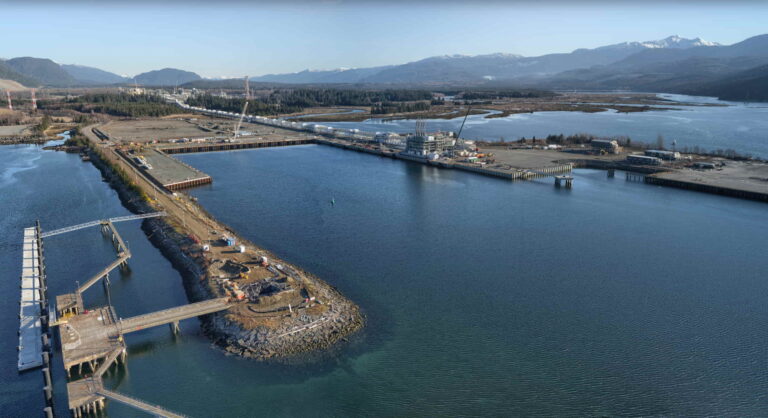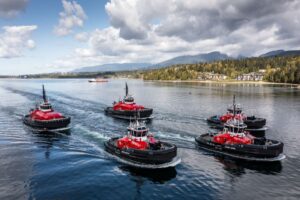Home Fossil Energy Canada’s first large-scale LNG export facility closing in on start-up date
LNG Canada, a joint venture company encompassing Shell, Petronas, PetroChina, KOGAS, and Mitsubishi, has made inroads in putting the required pieces in place to bring its liquefied natural gas (LNG) export terminal into operation later this year in Kitimat, Canada’s British Columbia. The latest milestone entails the completion of the final weld on the first production train.
 LNG Canada marine terminal, Kitimat, March 2024; Courtesy of Shell-led LNG Canada
LNG Canada marine terminal, Kitimat, March 2024; Courtesy of Shell-led LNG Canada
The placement of the final weld on the first production train at the Shell-led LNG Canada project marks “a pivotal moment” in the construction of what is said to be one of the largest energy projects in Canadian history, according to Fluor and JGC Corporation, which make up the JGC-Fluor joint venture in charge of delivering multiple aspects of this megaproject, including engineering, procurement, fabrication and delivery of modules, as well as construction of the project’s infrastructure and utilities, marine structures and LNG storage tank.
While over 380 pipe welders have worked on the project since construction began in 2018, the JV underlines that the final weld took 48 hours of continuous work from teams of welders working in shifts. With an initial capacity to produce 12.7 metric tonnes (14 million tons) of LNG per year, the first shipment from LNG Canada is expected by the middle of 2025, which is anticipated to put the Great White North on the map of LNG exporting countries.
Jim Breuer, President of Fluor’s Energy Solutions business, commented: “The significance of achieving the last weld to support train one completion is a testament to the collaborative efforts of the JGC-Fluor project team, subcontractors and a skilled and dedicated workforce. We are now one step closer to the introduction of gas and start-up.”
Since the start of construction, more than 30,000 Canadians have directly contributed to building Canada’s first LNG export facility, which was recently more than 90% completed overall. In anticipation of the start-up of LNG Canada, Petronas recently named three new LNG vessels built primarily for deliveries from North America to its customers.

Posted: 4 months ago
These three new vessels, Puteri Sejinjang, Puteri Mahsuri, and Puteri Mayang, described as energy-efficient, boost the total number of LNG ships dedicated to the Malaysian energy giant’s operations in North America to six. Featuring a cargo capacity of 174,000 cubic meters, these vessels are perceived to be the largest ships within Petronas’ multi-sized fleet of ships.
The latest vessel trio was preceded by the delivery and naming of the first three ships, Puteri Saadong, Puteri Ledang, and Puteri Santubong, in January 2024. The new LNG additions to the firm’s fleet were built at the Hyundai Heavy Industries (HHI) shipyard in Ulsan, South Korea,
Adnan Zainal Abidin, Petronas’ Chief Operating Officer, highlights that LNG, which he sees as a key component for a just energy transition, is here to stay for the foreseeable future. The company claims the expansion of its LNG fleet ramps up its readiness for the upcoming start-up of LNG Canada.
The cumulative value of the Canada LNG project’s contracts and subcontracts to local, Indigenous, and other businesses in B.C. has exceeded $4.7 billion and comes with more than $3.8 billion to Indigenous-owned and local area businesses.
Thanks to a $500 million contract with HaiSea Marine, a joint venture between the Haisla Nation and Seaspan that will provide harbor and escort tugboat services to LNG Canada with its fleet of battery-powered and low-emissions vessels, three battery-powered tugboats, HaiSea Wamis, HaiSea Wee’git, and HaiSea Brave, have been delivered as well as the first and second LNG-powered tugboats, Haisea Kermode and HaiSea Warrior.

Posted: 2 months ago
Previously, LNG Canada’s CEO highlighted that the project was designed with the lowest carbon intensity of any large-scale LNG export facility operating today, with 35% less emissions than the world’s best-performing facilities and 60% less than the global weighted average.
Once operational, the LNG project will consist of a natural gas receiving and LNG production unit and a marine terminal able to accommodate two LNG carriers, a tugboat dock, and LNG loading lines. In addition, it will contain LNG processing units, storage tanks, a rail yard, a water treatment facility, and flare stacks.
The LNG Canada project’s production capacity will be 14 million tonnes per annum (mtpa) from the first two trains, but this could be expanded to four trains in the future. There are seven LNG export projects and one infrastructure project in various stages of development in Canada, representing a possible capital investment of almost $109 billion and a potential production capacity of 50.3 mtpa of LNG.
While there are also four LNG liquefaction facilities, and two LNG import facilities, operating in Canada that serve the domestic market, mostly operating at low volumes, LNG Canada in Kitimat will be the country’s first large-scale LNG export facility once complete. The majority of the other projects target the start of operations between 2027 and 2030.
>>> Read full article>>>
Copyright for syndicated content belongs to the linked Source : OffshoreEnergy – https://www.offshore-energy.biz/canadas-first-large-scale-lng-export-facility-closing-in-on-start-up-date/































